Technology Applications In Agriculture By 2050, the world will need 70% more food because the population will grow fast. A UN study shows nearly 10% of people in the world still don’t have enough food. So, figuring out how to feed almost 10 billion people is a big challenge. To do this, we are using new technology in agriculture to make big changes.
New technology in agriculture is changing how we grow food. It gives farmers tools to feed more people with less impact on the planet. These tools include precision agriculture, indoor vertical farming, livestock technology, and farm automation. They help us farm in better, more sustainable, and productive ways.
Key Takeaways:
- Emerging agriculture technology is crucial to meeting the growing global demand for food production.
- Precision agriculture uses data-driven insights to optimize resource use and enhance sustainability.
- Indoor vertical farming increases crop yields in limited spaces using a controlled environment.
- Livestock farming technology provides data-driven insights to improve animal welfare and farm productivity.
- Farm automation reduces labor time and improves efficient operations through advanced machinery and data management.
Precision Agriculture
Precision agriculture is a smart way of managing farm resources using big data. It helps farmers grow better crops while using less. This includes making farms more sustainable, profitable, and productive. They do this by using data points to know exactly what each area of the farm needs most.
Resource Use Efficiency
New technologies in precision agriculture, like remote sensing and robotics, are changing farming. They let farmers watch fields closely and use resources better. This helps farms save money and is good for the planet because there’s less waste.
Sustainability
Precision agriculture helps farms keep going for a long time without hurting the environment. By using resources wisely, this method protects nature and ensures farms can be productive for many years.
Profitability
With the help of these new tools, farmers can make smarter choices that boost their profits. They can grow more crops using fewer resources. This means more money in their pockets.
Productivity
New technology is making farms work better and produce more. From machines that work the fields by themselves to using just enough of the right stuff, farmers are getting better results. And they’re wasting less.
Quality
Farmers can now fine-tune almost everything to make sure their crops are just right. They control water, nutrients, and keep pests away effectively. This means better quality food for us to enjoy.
Indoor Vertical Farming
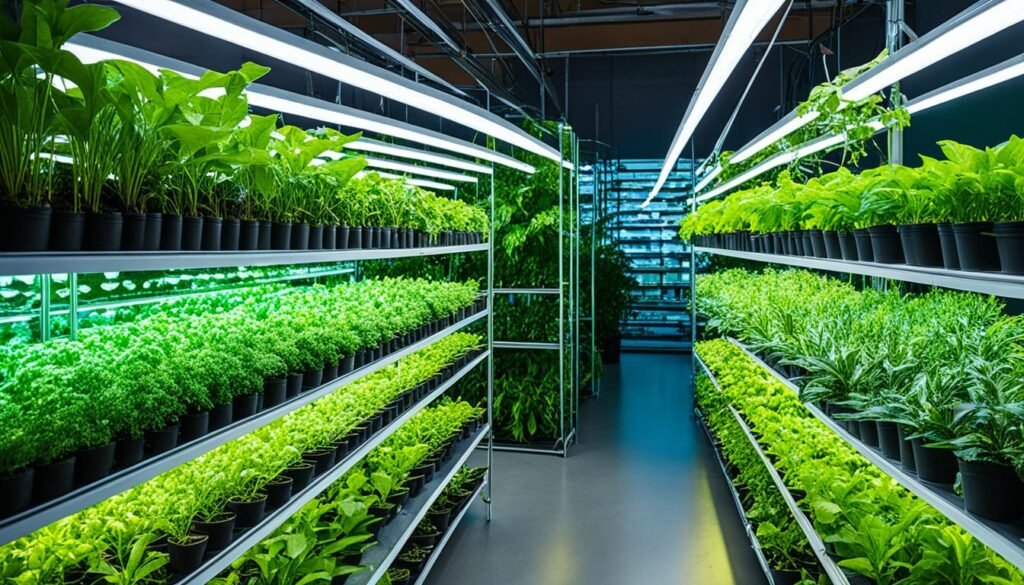
The average yield of rice/ha is 3-6 tonnes. But, with indoor vertical farming, farmers can surpass this. They grow produce using vertical stacks in a controlled environment. This boosts crop yield in small spaces.
Hydroponic Systems
In indoor vertical farming, hydroponic systems are key. They don’t use soil. Instead, they use water with mineral nutrients for plant growth. This way, reduced water usage is achieved. It’s efficient, sustainable, and offers control over growth conditions.
Aeroponic Systems
Aeroponic systems are also used. They grow plants with roots in the air, misting them with water. This technique saves water and encourages quicker plant growth. It ultimately increases the crop yields.
Controlled Environment
The biggest strength of indoor vertical farming is its controlled environment. By growing crops inside, farmers manage temperature, humidity, and light. They also control nutrients precisely. This creates the perfect growth conditions, without the negative effects of the outdoors.
Reduced Water Usage
Unlike traditional farming, indoor vertical farming uses much less water. It cuts water needs by up to 90%. This is a huge benefit, especially in dry areas. It’s a very sustainable method.
Automated Harvesting and Planting
Indoor vertical farming uses automation to farm more efficiently. Robots take care of harvesting and planting. This lowers labor costs while making the farming process more efficient and productive.
Livestock Farming Technology
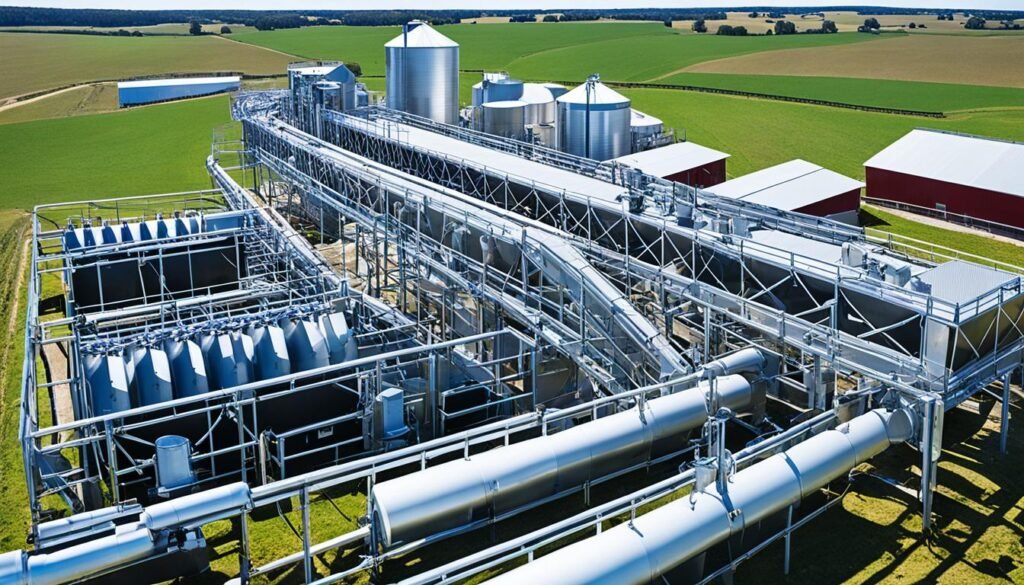
Farming is changing thanks to new tech. Livestock tech is making farms more productive, animals happier, and the earth safer. With these tools, farmers get smart info to manage their farms better and work more efficiently.
Automated Dairy Installations
Now, cows can be milked on their own with automated systems, no human needed. These systems use sensors to check on milk quality. This means farmers always know how their herd is doing. It lets them focus on other important farm jobs.
Automated Cleaning Systems
It’s important that where the animals live is clean. Robots and sensors are being used in barns to keep things tidy. This saves time and effort that can go into taking better care of the animals.
Non-Antibiotic Treatments
Too much antibiotic use is a worry, so new treatments are being developed. Things like phytogenic feed additives and probiotics are being used. These new ways can keep animals healthy without using lots of antibiotics. This is good for the animals and helps prevent antibiotics from becoming less effective.
Automated Feeder Systems
Feeding animals is getting more precise with new tech. Systems check the feed and give exactly what each animal needs. This helps animals stay healthy and cuts down on food waste, making the farm more efficient.
Robotics and AI Integration
Robots and AI are changing farming in big ways. Robots can handle many jobs, AI helps manage the farm better. With this tech, farmers can make better choices about caring for their animals. This makes the farm work smoother and smarter than ever before.
Laser Scarecrows
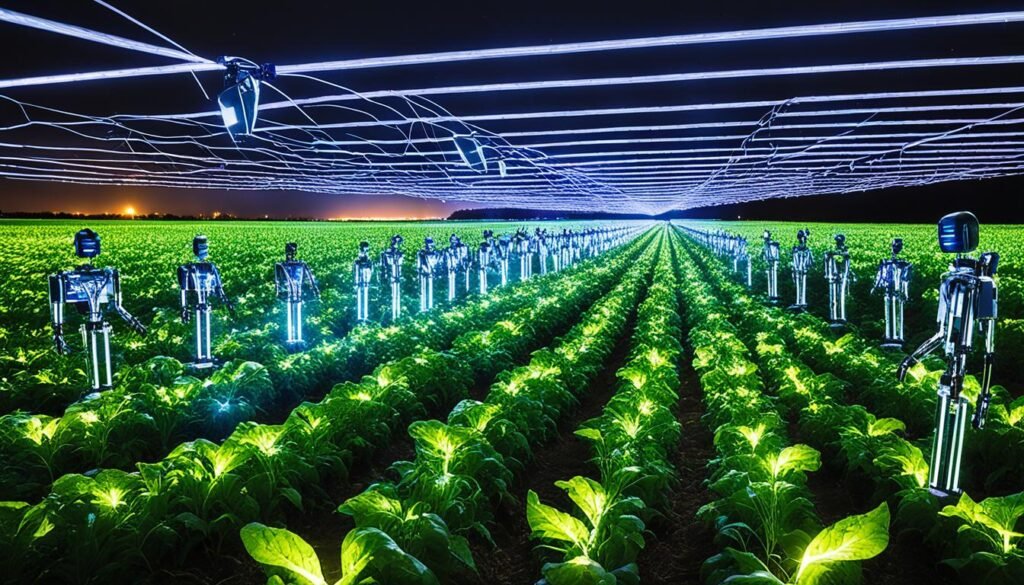
Birds or rodents can harm crops in an open field. In the past, farmers used scarecrows to scare them off. Now, they are using motion sensor devices. These devices keep birds from eating the crops.
Laser scarecrows are the new thing. They sense when birds or pests are near. Then, they shoot harmless lasers at them. Placing these systems across the field, the crops stay safe from birds.
The laser scarecrows work well against pests. They can detect where the pests get in and aim the lasers there. This keeps the birds away in a safe way. It also helps crops grow healthy without harm to birds or the environment.
By using laser scarecrow systems, farmers can protect their fields. They keep the pests away while letting the crops grow well. This is a smart, eco-friendly way to manage pests. As farming changes, technology like this becomes more important for a secure food future.
Farm Automation

Farm automation combines tech like machinery, computer systems, and sensors to make farming more efficient. It uses things like autonomous tractors, robotic harvesters, and automated weeding. This tech helps farmers do things faster, get more crops, and use resources well.
Autonomous Tractors
Autonomous tractors are changing how farms work. They can farm on their own, keeping track of fields and soil. Thanks to data management and smart farming, they work accurately. This makes farming more efficient.
Robotic Harvesters
Robotic harvesters pick crops without people. They use technology to see what’s ready to harvest. Then, they collect the crops gently and sort them. This makes farming faster and the crops better.
Automated Seeding and Weeding
New tech lets farmers plant and remove weeds with less work. Planters put seeds exactly where they need to go with GPS. Robotic weeders, with their special eyes and tools, find and remove weeds. Farmers use less people and chemicals, making farming eco-friendlier.
Reduced Labor Time
Farm automation helps cut how much work farmers need to do. It takes over planting, picking, and weeding. This frees up farmers to focus on other important farm work. Overall, it helps farms be more productive and make more money.
Real-Time Kinematic (RTK) Technology

In modern agriculture, real-time kinematic (RTK) technology is making a big difference. It gives farmers very precise tools to work with. Using satellites, RTK provides centimeter-level accuracy. This changes how farmers plan and handle their fields.
Centimeter-Level Accuracy
RTK technology lets farmers map their lands in great detail, down to the centimeter. With this, they can make smart choices to use resources better. This leads to increased productivity and happier, healthier soil.
Permanent Traffic Lanes
RTK also makes permanent traffic lanes for farm vehicles. It sends the right positions to tractors and more using radio. This keeps them on exact paths, cutting down on issues like soil compaction. This means soil health gets better.
Soil Health Improvement
Thanks to RTK, soil health is on the up. It reduces how much soil is pressed down and stays undisturbed. This keeps the soil’s natural structure and nutrient composition intact. As a result, farms work better and last longer. It’s good for the land and for growing food.
Minichromosome Technology
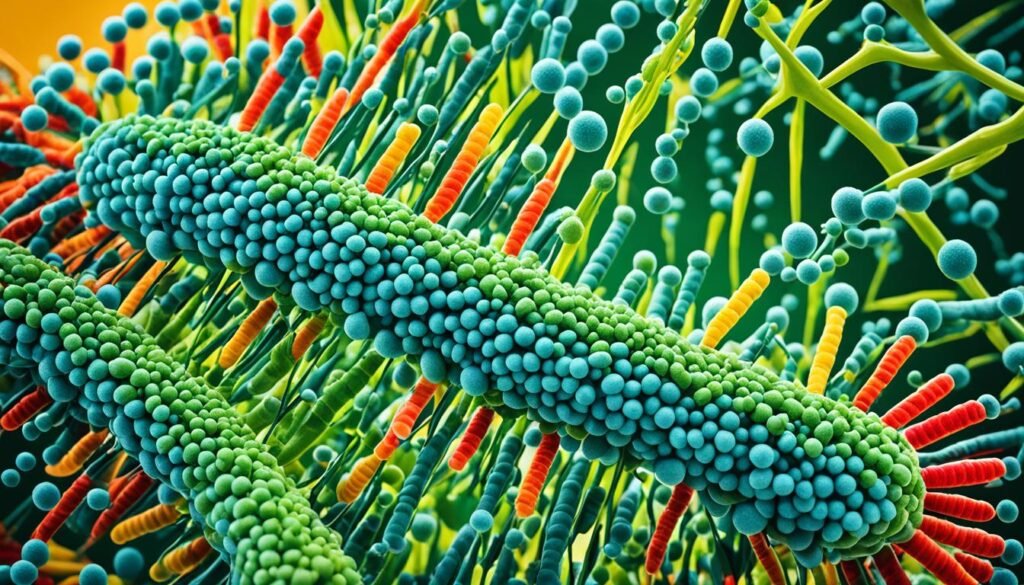
GM food has been getting critiqued lately. People worry about allergies and toxins in the food. They also fear that GM crops might hurt nature or poison the soil. Luckily, minichromosome technology is offering fixes for these problems.
Drought-Tolerant Crops
This tech makes drought-tolerant crops. These plants can survive where water’s scarce. They are modified to need less water and to grow well without lots of fertilizers and pesticides.
Pest-Resistant Crops
It can also create pest-resistant crops. These plants don’t need insecticides that can harm nature. By adding traits that pests don’t like or can’t harm, we can protect crops in a safer, greener way.
Biofortification
Moreover, this technology boosts the nutrition in crops, a process called biofortification. It increases vitamins, minerals, and other nutrients in the plants. This helps fight worldwide malnutrition and enhances food’s quality everywhere.
Farm Management Software
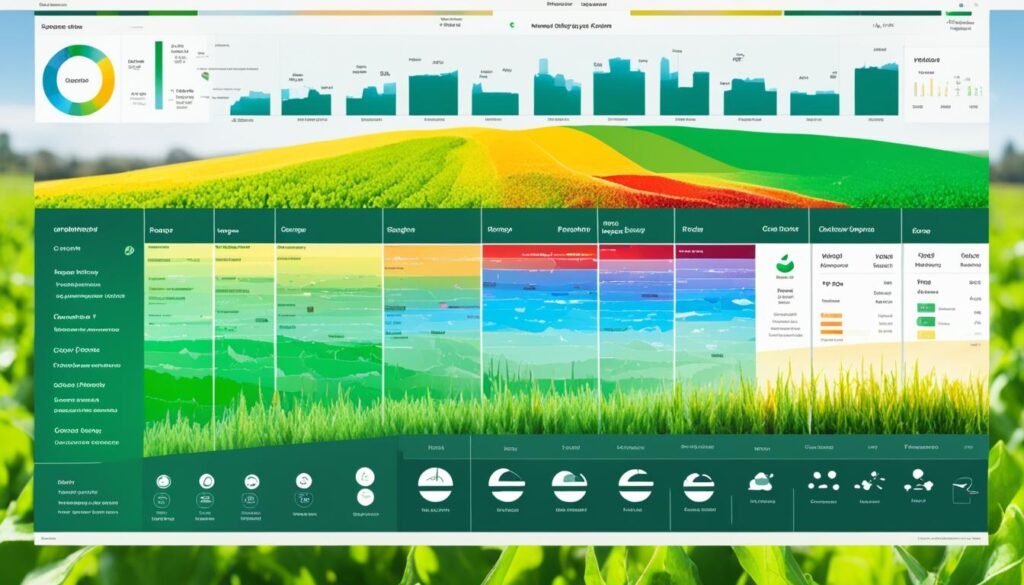
For many farmers, managing a lot of work with few helping hands can be tough. It gets even harder with a larger farm to look after. Thanks to farm management software, farmers can now access real-time data and information. This helps them understand their farm better and make smarter choices for all parts of their farm work.
Streamlined Operations
Farm management software offers tools to make life easier for farmers. It does this by handling many tasks automatically, like keeping track of what’s in stock or how the money is spent. With all these farming tasks under one easy-to-use system, productivity goes up. This means farmers can spend more time thinking about their next best move rather than getting lost in small details.
Enterprise Resource Planning
Some farm management software goes even further by including enterprise resource planning (ERP) features. This gives farmers a full picture of their farm’s business side. It makes tasks like tracking supply chains or managing livestock more efficient. With the help of ERP, farms can use their resources better. They can also make better big-picture decisions that help their farm succeed in the long run.
Water Management Technology
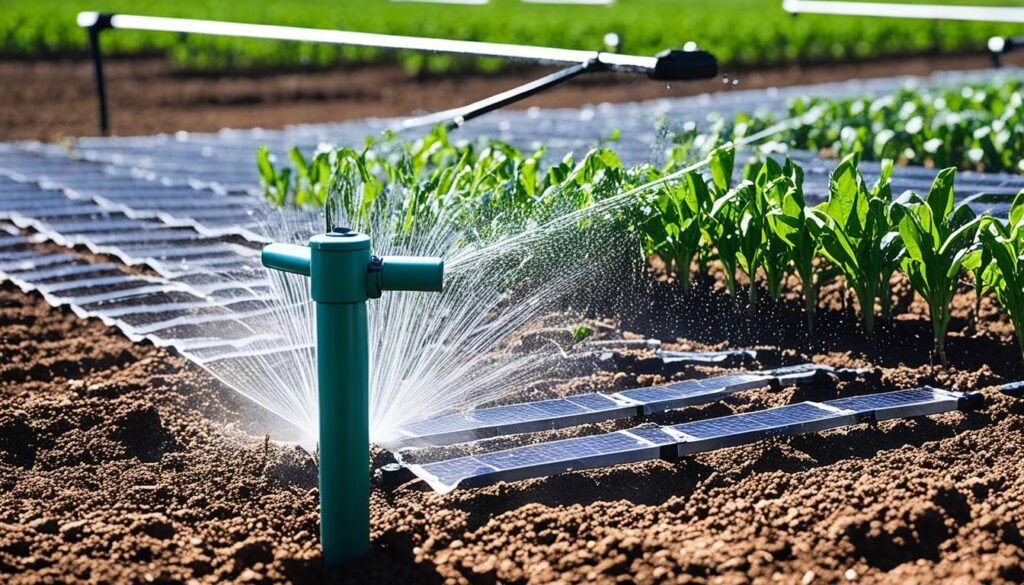
Irrigation helps drylands by providing necessary water. Without it, these lands wouldn’t be farmable. But, using too much water in irrigation can be harmful. It can lead to problems like soil degradation, contaminating water, and emitting greenhouse gases. Unfortunately, many farmers still follow old, wasteful methods from over 4,000 years ago.
Smart Irrigation Systems
Smart irrigation systems have changed the game. They use sensors to check if the soil is dry, the weather, and how much water plants need. Then, they adjust automatically to use just the right amount of water. This makes irrigation more efficient and uses less water. It also helps protect the environment by reducing negative impacts from farming practices.
Moisture Monitoring
Moisture monitoring gives farmers real-time updates on the moisture in their soil. With this data, they can decide when and how much water to use for their plants. This ensures that crops get just the right amount of water, not too much or too little. By using this data, farmers can improve their irrigation timing. This saves water, reduces waste, and helps the environment.
Precision Application
Precision application tech lets farmers water, fertilize, and spray for pests accurately. It uses sensors, GPS, and computer apps to target specific spots in fields. This way, the exact amount of needed water or other substances is applied. This approach is better because it saves water, cuts down on chemical use, and is good for the environment.
Technology Applications In Agriculture
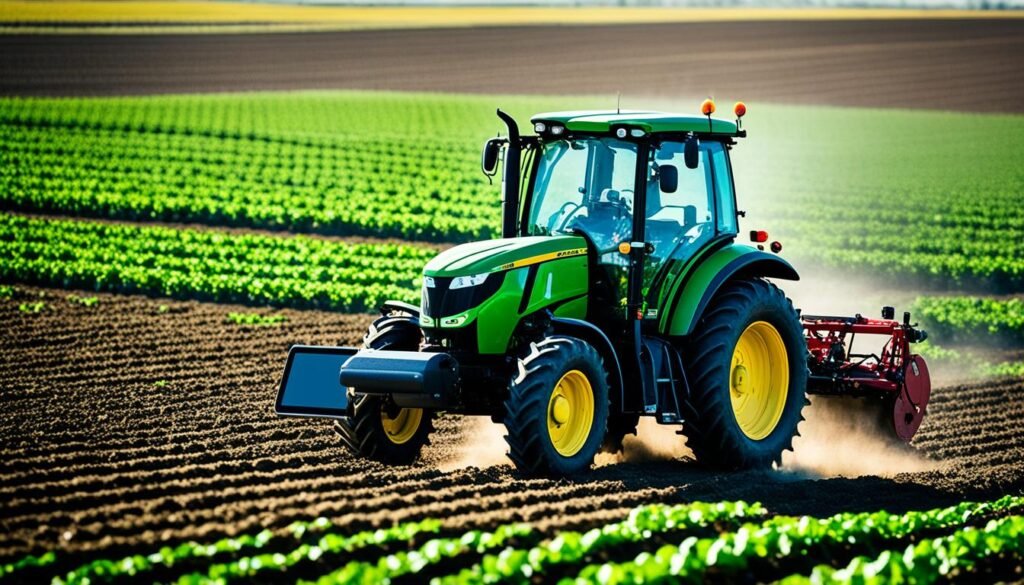
The newest tech tools in agriculture are changing how farming is done. They’re making farming smarter and more sustainable. Precision agriculture leads this change. It uses data from the latest tech to farm in a more efficient and planet-friendly way.
Precision Agriculture
Precision agriculture uses smart devices like sensors, drones, AI, and IoT. They gather real-time data on things like soil, weather, and crop health. This data helps farmers make better choices. They can grow more crops, use less water, and reduce the need for harmful chemicals. This means farming is both more effective and better for the environment.
Smart Sensors
Smart sensors are giving farmers a close eye on their fields. They measure things like soil moisture and plant stress. This data helps spot issues early and apply solutions where they’re needed most.
Drones
Drones are aerial helpers in precision agriculture. They take high-quality pictures and scan crops with special sensors. This allows farmers to see if something’s wrong with their plants, like pests or diseases. Then, they can treat those areas specifically, saving time and resources.
Artificial Intelligence
AI is a big deal in agriculture. It crunches the numbers from all the tech tools. This helps it predict things like how many crops will grow. AI also suggests the best ways to farm. These insights make farming more productive and eco-friendly.
Internet of Things (IoT)
IOT connects farm equipment and devices to the internet. This means farmers can check on their crops and machines from anywhere. It also helps save resources like water and reduce waste. Farming this way is more efficient overall.
Data Analytics
Big data from these tech tools is analyzed to give farmers important info. This includes forecasts on how well crops will do, and advice on soil health. With this knowledge, farmers can manage their fields in the best way possible. They can also monitor their crops closely and run their farms more effectively.
Also Read: Digital Transformation: Strategies For Integrating New Business Technology
Conclusion
The newest technology applications are changing agriculture for the better. Farmers now have amazing tools to feed the world and protect our planet. These include precision agriculture, indoor vertical farming, and more.
Thanks to high-tech insights, farmers use resources better and grow more crops. This is key as we need to feed more people and keep our earth healthy.
As the agriculture industry grows, using these advanced tools is critical. They help make food production better for the future. Farming smart can lead to a strong and green agricultural sector.
FAQs
Q: What is smart agriculture?
A: Smart agriculture refers to the integration of modern technology into traditional farming practices to increase efficiency, productivity, and sustainability in the agricultural sector.
Q: How is crop monitoring used in agriculture?
A: Crop monitoring involves the use of advanced technologies such as drones, satellite imagery, and sensors to track the health, growth, and yield potential of crops in real-time.
Q: What is precision agriculture technology?
A: Precision agriculture technology utilizes data analytics, sensors, and GPS technology to optimize farming practices, reduce waste, and improve crop yields by enabling farmers to make precise decisions based on specific conditions.
Q: What is agriculture 4.0?
A: Agriculture 4.0 refers to the latest phase of technological advancements in the agriculture sector, involving automation, robotics, artificial intelligence, and big data analytics to revolutionize farming practices and create more sustainable food production systems.
Q: How has technology transformed the evolution of agriculture?
A: Technology has significantly influenced the evolution of agriculture by introducing innovative tools and systems that enhance efficiency, sustainability, and productivity in farming practices.
Q: What are some examples of smart agricultural technology?
A: Smart agricultural technology includes IoT devices, automated irrigation systems, crop monitoring drones, RFID technology, and GIS-based solutions that help farmers manage their operations more effectively.
Q: How does sustainable farming benefit from technological advancements?
A: Sustainable farming leverages advanced technologies to minimize environmental impact, conserve resources, optimize production processes, and promote long-term resilience in agricultural practices.




